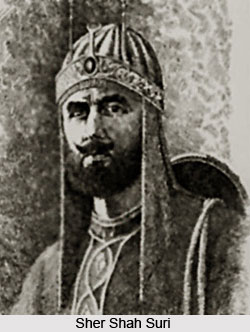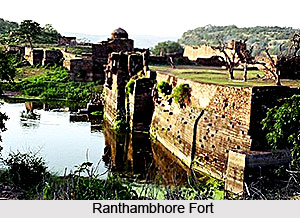 Sher Shah Suri was an Afghan ruler who succeeded in building an Afghan empire in northern India. Sher Shah is one among those great personalities of history who had a humble beginning but succeeded in establishing powerful empire simply by his own exertions, merit and power of sword. Sher Shah did not belong to a rich family and in no way was connected with a royal family or with any well-known military commander or religious preacher. Thus, he was a man without any high connections, influence or status and he did not get any support from anybody in his career. Whatever he achieved, he achieved simply by his own efforts and capability.
Sher Shah Suri was an Afghan ruler who succeeded in building an Afghan empire in northern India. Sher Shah is one among those great personalities of history who had a humble beginning but succeeded in establishing powerful empire simply by his own exertions, merit and power of sword. Sher Shah did not belong to a rich family and in no way was connected with a royal family or with any well-known military commander or religious preacher. Thus, he was a man without any high connections, influence or status and he did not get any support from anybody in his career. Whatever he achieved, he achieved simply by his own efforts and capability.
Early Life of Sher Shah Suri
Sher Shah was called Farid when he was a child and was born in 1472 A.D. at the age of twenty two Sher Shah fled to Jaunpur which was the center of learning at that time, studied there for three years, acquired knowledge of Arabic and Persian and was able to impress Jalal Khan, the master of his father by his knowledge and labour. Sher Shah was appointed as the deputy of the Jagir of his father. He looked after the Jagir of his father for about twenty years (1497-1518 A.D.) and managed its administration very well. After that Sher Shah entered the service of Bahar Khan, the master of south Bihar. Here he got the title of Sher Khan after killing a tiger single-handed in a hunting excursion. Bahar than was so much pleased with his services that he appointed his deputy in the administration.
In 1526 A.D. Ibrahim Lodi was defeated at the first battle of Panipat by Babur and therefore many Afghan nobles declared their independence. Bahar Khan was also one of them. He declared himself the ruler of south Bihar and assumed the title of Sultan Muhammad. The growing influence of Sher Khan on Sultan Muhammad provoked the jealousy of certain nobles and agitated the Sultan against him. Sher Khan was forced to leave Khar. He went to Agra and took up service under the Mughal ruler Babur. But, very soon, he felt insecurity of his life and fled away from the Mughal camp. In 1529 A.D., he joined Mahmud Lodi to fight against Babur. The Afghans were defeated at the battle of Ghaghara. Nusrat Shah of Bengal attacked south Bihar but was defeated by Sher Khan who, by that time, had monopolised its administration. The Lohani nobles could not tolerate Sher Khan any more and conspired to murder him. But they failed and Sher Khan, who assumed the title of Hazrat-i-Ala, became the virtual ruler of south Bihar.
Contest for the empire by Sher Shah Suri
The success against the army of Bengal and occupation of south Bihar inflamed the ambitions of Sher Khan. He now started organising the Afghans and called them from distant places to assemble under him. In 1530 A.D. Humayun became the Mughal emperor and the Afghans decided to fight against him under Mahmud Lodi. They assembled in Bihar and Sher Khan also had to join them though he had no faith in the leadership of Mahmud Lodi. The Afghans were defeated in 1532 A.D. at the battle of Dauhria. Mahmud Lodi fled away and this provided Sher Shah the opportunity of leading the Afghans against the Mughals. Humayun had laid the siege of Chunargarh after the defeat of the Afghans in 1532 A.D. The fort was under Sher Khan and was well defended by his son Jalal Khan. After four months of siege. Humayun decided to withdraw and made peace with Sher Khan and allowed him to retain south Bihar and Chunargarh in return of acceptance of the suzerainty of the Mughals.
 While Humayun remained busy in the west for the next few years, Sher Shah utilised the opportunity to establish his power in the east. He attacked Bengal and the battle of Surajgan was fought against the army of Bengal in 1534 A.D. and complete success was by Sher Shah. He defeated Humayun in the battle of Chausa in 1539 A.D. After this battle, he assumed the title of Sher Shah Sultan-i-Adil with the consent of all his present Afghan nobles. Thereafter, he attacked Bengal and became the master of Bengal and Bihar. In 1540 A.D., he again defeated Humayun at the battle of Kannauj. He then occupied cities like Agra, Delhi, Sambhal, Gwalior, Lahore and all the territory of the Mughals. He thus, established the second Afghan Empire in India.
While Humayun remained busy in the west for the next few years, Sher Shah utilised the opportunity to establish his power in the east. He attacked Bengal and the battle of Surajgan was fought against the army of Bengal in 1534 A.D. and complete success was by Sher Shah. He defeated Humayun in the battle of Chausa in 1539 A.D. After this battle, he assumed the title of Sher Shah Sultan-i-Adil with the consent of all his present Afghan nobles. Thereafter, he attacked Bengal and became the master of Bengal and Bihar. In 1540 A.D., he again defeated Humayun at the battle of Kannauj. He then occupied cities like Agra, Delhi, Sambhal, Gwalior, Lahore and all the territory of the Mughals. He thus, established the second Afghan Empire in India.
Extension of the Empire under Sher Shah Suri
Sher Shah`s chief concern was to safeguard his empire from any fresh invasion of the Mughals. His second task was the extension of his empire and its consolidation. Therefore, he engaged himself in the double task of making further conquests and administering his empire till his death in1545 A.D. He introduced novelty in the administration of Bengal to check the possibilities of future revolt in that distant province. He divided Bengal into several districts and placed each of them under a military officer called the Shinqdar with a small force. The Shinqdars were placed under a civil officer called Amin-i-Bangla. Sher annexed a major portion of Malwa and forced the governor of the fort of Ranthambhor to surrender to him. Sher Shah was successful in capturing Multan and part of Sindh and also reduced Rajasthan to submission. After the conquests of Malwa and Rajasthan, Sher Shah decided to conquer Kalinjar and Bundelkhand. Kalinjar was of administrative and military importance to Sher Shah who was eventually successful in capturing it. Sher Shah succeeded in capturing practically entire northern India except Kashmir, Assam and Gujarat. He proved himself a capable administrator as well. Therefore, he occupies an important place among the rulers of medieval India.
Administration under Sher Shah Suri
Sher Shah showed brilliant capacity as an organiser, both in military and civil affairs. He had the greatest administrative and military genius among the Afghans. All his administrative measures succeeded in bringing out order, peace, strength and prosperity to the state as well as to his subject. He concentrated all administrative powers in his own person. His ministers did not make decision themselves. All major decisions were taken by Sher Shah himself and the ministers and the nobles simply carried them out. There were departments whose administrate heads enjoyed the position of ministers such as the Diwan-i-wazirat, the Diwan-i-arz, the Diwan-i-rasalat and the Diwan-i-insha. The main sources of income of the state were the land-revenue, unclaimed property, trade-tax, mint, salt-tax, Khams, viz. one fifth of the plunder taken during the time of war, Jizya and presents from subordinate rulers, governors, nobles, traders etc. The main items of expenditure were the expenses to maintain the army, salaries of civilian officers and the expenditure of the royal household and the Sultan. His revenue administration has been regarded as one of the best during the medieval period.
There was no separate department of police and the duty was performed by the military officers in their respective areas. The local officials were held responsible for maintaining law and order and if they failed they were punished. Sher Shah abolished all those duties which were charged on merchandise at different places within his empire. He ordered for the collection of trade-tax only at two places, one, when and where the goods entered the territory of his empire and, the other, where it was sold. This encouraged trade and commerce. Sher Shah stopped the use of all old coins and issued new coins of gold, silver and copper of all denominations of standard weights and of good metals. One of the greatest achievements of Sher Shah in administration was his construction of roads connecting important parts of his empire with his capital. Sher Shah maintained a highly efficient espionage system. Spies were appointed at all important places and with all important officers. Sher Shah strictly followed the principles of Islam in his personal life. He was a tolerant monarch which is proved by the activities pursued in the fields of religion, literature and fine arts during his times. He was undoubtedly one of the greatest statesmen of the medieval period.
Primarily, Sher Shah was a practical man. He clearly understood his aim and attempted to achieve it in a cold and circulated manner. Sher Shah studied Arabic and Persian, was interested in history and patronised scholars. He believed in acquiring worldly success and he achieved it. He was a religious man as well and had complete faith in God. He performed his daily religious rites punctually, arranged for charity to the poor and worked hard for the welfare of his subjects. Sher Shah did not lack the qualities of a soldier or that of a commander. He was courageous, capable of hard labour and expert in handling all weapons. He had killed a tiger single handedly in his young age and was awarded the title of Sher Khan by his then master. He participated in many wars as a soldier. He developed the art of winning the war with minimum cost and risk to himself. Therefore, he never lost a war during his life. Sher Shah was also a capable organiser and possessed all the virtues of a successful worldly-wise individual.



















